

Endolimax nana (Nonpathogen)
Organism:
This organism belongs to the amebae, is a nonpathogen, and causes no disease. Both the trophozoite (usual size, 8-10 µm) and cyst forms (usual size, 6-8 µm) can be found in clinical specimens.
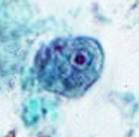
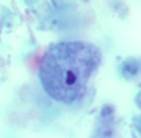
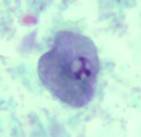
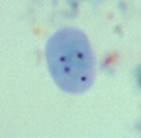
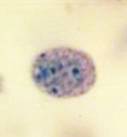
Endolimax nana cysts
Life Cycle:
Intestine, organisms passed in feces
Acquired:
Fecal-oral transmission via cyst form; contaminated food and water
Epidemiology:
Worldwide, primarily human-to-human transmission
Clinical Features:
None
Clinical Specimen:
Intestinal: Stool
Laboratory Diagnosis:
Intestinal: Ova and Parasite examination (concentration, permanent stained smear); identification based on morphology
Organism Description:
Trophozoite: No nuclear chromatin, large karyosome, relatively clean cytoplasm (may contain some debris); tremendous nuclear variation (can mimic Entamoeba hartmanni, Dientamoeba fragilis and Iodamoeba bütschlii).
Cyst: May contain linear structures (pale), mature cyst contains 4 nuclei (rare to see two-nucleated stage).
Laboratory Report:
Endolimax nana (indicate cysts and/or trophozoites)
Treatment:
None
Control:
Improved hygiene, adequate disposal of fecal waste, adequate washing of contaminated fruits and vegetables
Comments:
E. nana trophozoites can be difficult to differentiate from other organisms; note the tremendous nuclear variation in the trophozoite stage (see above).